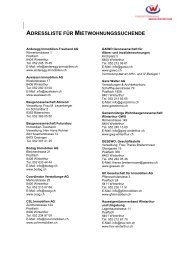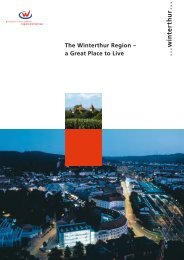Handbook for Investors. Business location in Switzerland.
Handbook for Investors. Business location in Switzerland.
Handbook for Investors. Business location in Switzerland.
You also want an ePaper? Increase the reach of your titles
YUMPU automatically turns print PDFs into web optimized ePapers that Google loves.
Swiss Federal Institute of Intellectual Property (IGE)<br />
www.ige.ch<br />
Languages: German, English, French, Italian<br />
• International patent: The Patent Cooperation Treaty (PCT),<br />
which <strong>Switzerland</strong> has ratified, enables <strong>in</strong>ventors to submit an<br />
<strong>in</strong>ternational registration which then has the same effect as a<br />
national registration <strong>in</strong> all named member states. International<br />
registrations can be submitted to the IGE <strong>in</strong> English.<br />
Protective rights register<br />
www.swissreg.ch<br />
Languages: German, English, French, Italian<br />
It takes an average of three to five years between an application<br />
be<strong>in</strong>g filed and the patent be<strong>in</strong>g granted. Patents expire after a<br />
maximum of 20 years. For topographies or three-dimensional<br />
structures of semiconductor products, the protection period is ten<br />
years. A patent costs CHF 200 <strong>for</strong> the application and CHF 500<br />
<strong>for</strong> the <strong>in</strong>vestigation. Annual renewal fees are payable start<strong>in</strong>g five<br />
years after the date of fil<strong>in</strong>g.<br />
World Intellectual Property Organization (WIPO)<br />
<strong>Switzerland</strong> is one of the most active countries <strong>in</strong> the OECD <strong>in</strong><br />
terms of the number of patent applications per <strong>in</strong>habitant.<br />
www.wipo.<strong>in</strong>t<br />
Languages: English, French, Spanish, Ch<strong>in</strong>ese, Russian<br />
Europe's network of patent databases<br />
3.3.1 Patents<br />
Inventions that solve a technical problem by technical means can<br />
be protected with a patent. To be eligible <strong>for</strong> a patent, the <strong>in</strong>vention<br />
must meet three basic criteria:<br />
• Commercial application: The <strong>in</strong>vention must be commercially<br />
usable, actually realizable and repeatable.<br />
• Novelty: An <strong>in</strong>vention is considered novel when it is not already<br />
state-of-the-art.<br />
• Non-obviousness: The <strong>in</strong>vention must not be obviously (<strong>for</strong> an<br />
expert) related to the state of the art.<br />
Ideas, lottery or account<strong>in</strong>g systems, therapeutic, surgical or<br />
diagnostic procedures, animal breeds and plant species cannot<br />
be patented.<br />
There are three ways to protect an <strong>in</strong>vention with a patent application<br />
effective <strong>in</strong> <strong>Switzerland</strong>:<br />
• Swiss patent: With national registration, the patent protection<br />
extends to <strong>Switzerland</strong> and the Pr<strong>in</strong>cipality of Liechtenste<strong>in</strong>.<br />
• European patent: The European Patent Convention (EPC)<br />
enables applicants to obta<strong>in</strong> protection <strong>in</strong> the member states of<br />
the EPC, <strong>in</strong>clud<strong>in</strong>g <strong>Switzerland</strong>, through a standardized patent<br />
<strong>in</strong>vestigation and grant<strong>in</strong>g procedure.<br />
www.espacenet.com<br />
Languages: German, English, French<br />
Patent attorneys<br />
www.ige.ch<br />
Languages: German, English, French, Italian<br />
3.3.2 Brands<br />
It is advisable to register trademarks and brands <strong>in</strong> good time <strong>in</strong><br />
both the home market and the most important export markets. In<br />
most cases, application <strong>for</strong> trademark protection <strong>in</strong> <strong>for</strong>eign countries<br />
follows on from the trademark’s registration <strong>in</strong> <strong>Switzerland</strong>.<br />
Be<strong>for</strong>e register<strong>in</strong>g the planned trademark <strong>in</strong> the trademark register<br />
and the commercial register, it is important to f<strong>in</strong>d out whether<br />
other trademarks exist that are identical or so similar as to cause<br />
confusion. Specific searches can be conducted onl<strong>in</strong>e, and all the<br />
data needed <strong>for</strong> the registration of Swiss trademarks can also be<br />
entered and submitted onl<strong>in</strong>e.<br />
<strong>Handbook</strong> <strong>for</strong> <strong>Investors</strong> 2010<br />
31









